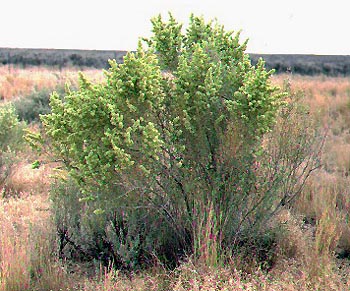Fourwing Saltbush

Common Name(s):
Fourwing Saltbush
Scientific Name:
Atriplex canescens (Pursh) Nutt.
Scientific Name Synonyms:
None known
Symbol:
ATCA2
Description:
Life Span: Perennial
Origin: Native
Season: Evergreen
Growth Characteristics: An erect, stout, and much-branched shrub, growing 1 to 7 feet tall, and 1 to 15 feet in crown diameter. Flowers May to September and reproduces from seed.
Flowers/Inflorescence: Flowers occur in panicles. Male and female flowers are usually borne on separate plants. The male flowers grow in dense clusters arranged as spike-like branches in a terminal panicle and are green in color. Female flowers grow in short axillary spikelets, appearing as a terminal panicle, yellow in color.
Fruits/Seeds: Fruit is a utricle, enclosed in a pair of 2-winged bracts, giving it the "fourwing" appearance.
Leaves: Alternate or occurring in fascicles (like pine needles). Blades are oblong to wide oval to lance-shaped, 3/8 inch wide and 2 inches long. Margins are entire and may be rolled. The surfaces are thick gray and scurfy.
Stems: Twigs are rigid, gray to yellowish or tan, pubescent when young becoming glabrous (without hair). The bark is thin, tight, gray, and lightly grooved.
Ecological Adaptions:
Fourwing saltbush is well adapted to a wide range of temperature and soil conditions. It is highly tolerant of drought, salinity, and alkalinity. Fourwing saltbush occurs on sand dunes, in gravelly washes, on mesas, ridges, alluvial plains, and slopes, at elevations between 3,000 and 8,000 feet.
Soils: Common on many different soil types, most common on deep, well-drained, sandy (often alkaline) soils in the desert and foothill ranges of the Great Basin. However, it also grows well on heavy clay and on selenium-enriched soil.
Associated Species: Bottlebrush squirreltail, Rubber rabbitbrush, big sagebrush, shadscale, and greasewood.
Uses and Management:
Fourwing saltbush is a valuable browse that tolerates heavy use. It is used extensively by many wildlife species and domestic livestock, and provides fair to good forage for domestic sheep, goats, and cattle. Leaves usually remain succulent during the hot, dry summer months and can provide some forage even in years when annuals fail. Fourwing saltbush generally provides good deer browse during all seasons and is used by elk in winter. Pronghorns may feed on this shrub to some extent during all seasons of the year. Fourwing saltbush is a preferred browse of many rabbits and small mammals. Seeds are readily eaten by upland game birds, small nongame birds, and rodents.
On rare occasions, fourwing saltbush has caused scours, bloat, and anemia in domestic livestock.
Fourwing saltbush has been widely used for rehabilitating mine spoils, roadsides, and oil well reserve pits high in soluble salts. It is well suited for revegetating saline sites.
Indians ground the seeds to make flour for bread. The pollen of fourwing saltbush commonly causes hay fever.

